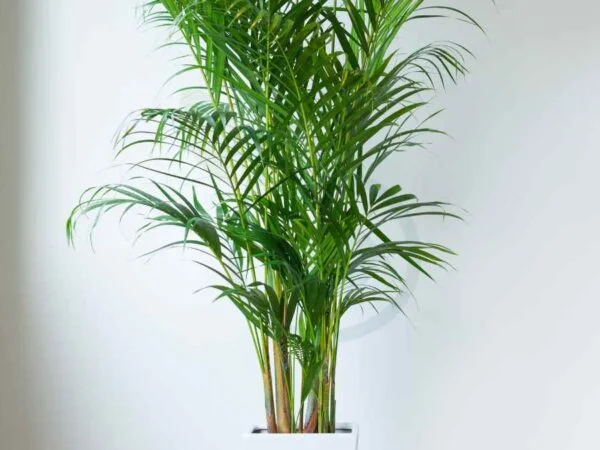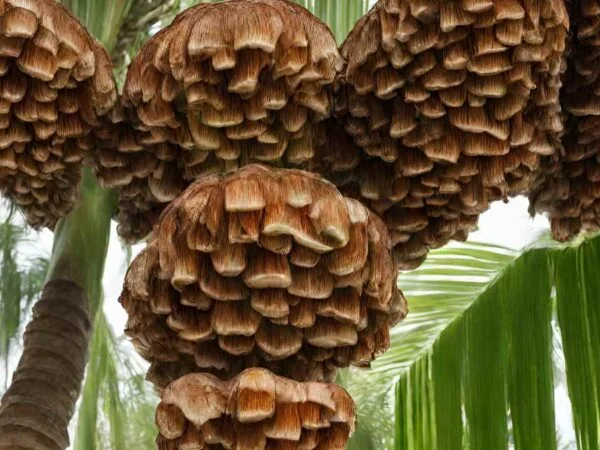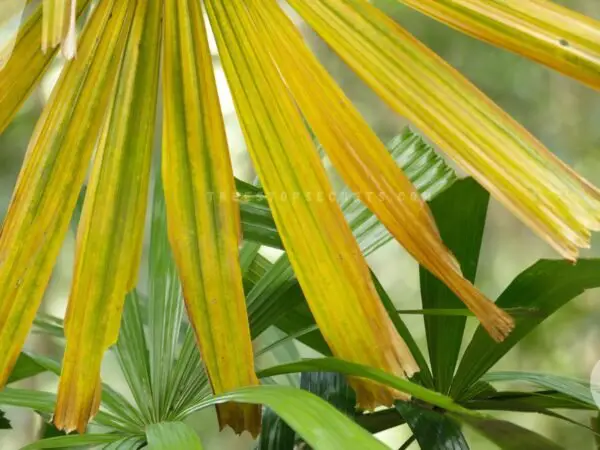Cat palm tree care can be straightforward with the right guidance. Known for their lush, feather-like fronds, cat palms (Chamaedorea cataractarum) are popular indoor plants. To help your cat palm thrive, I provide essential tips on watering, light requirements, and maintenance. With proper care, your cat palm can flourish, adding a tropical touch to your home. Whether you're a novice or experienced gardener, my advice will help you keep your cat palm healthy and vibrant.
Caring for a cat palm involves maintaining specific conditions to ensure its health. Here are the primary care tips:
| Aspect | Requirement |
|---|---|
| Light | Bright, indirect light |
| Watering | Keep soil consistently moist |
| Humidity | Prefers high humidity |
| Temperature | 65-80°F (18-27°C) |
| Soil | Well-draining, peaty soil |
Cat palms thrive in bright, indirect light and should be watered regularly to keep the soil moist but not waterlogged. They prefer high humidity and temperatures between 65-80°F (18-27°C). Use well-draining, peaty soil for best results.
I have additional tips and detailed advice to keep your cat palm looking its best. For further guidance on troubleshooting common issues and optimizing care, explore my full range of resources.
Key Takeaways
- Understand the specific care needs of cat palms for successful growth and health.
- Provide essential care indoors by ensuring proper watering, lighting, and humidity levels.
- Implement advanced indoor care techniques like fertilizing and pest control to maintain thriving cat palms.
- Pot and repot cat palms as needed, using well-draining soil and suitable containers.
- Transition cat palms outdoors gradually to acclimate them to new light and temperature conditions.
- Follow seasonal care routines and troubleshoot common issues promptly to keep cat palms flourishing.
Understanding Cat Palm Care
Growth Basics
Cat palms are known for their slow growth, elegant fronds, and slender green stems. Beginners find caring for them rewarding.
- Slow growth is a characteristic feature of cat palms.
- The fronds of cat palms are elegant and grow from slender green stems.
- Beginners often find caring for cat palms to be a rewarding experience.
Indoor vs Outdoor
Cat palms have different growth requirements based on whether they are grown indoors or outdoors. They thrive indoors due to their adaptability to indoor conditions.
- Cat palms have specific requirements for both indoor and outdoor growth.
- Indoor conditions are suitable for cat palms due to their adaptability.
- Lighting plays a crucial role in determining the growth of cat palms, whether indoors or outdoors.
Essential Care for Indoor Cat Palms
Light Needs
Cat palms thrive in bright, indirect light to support their growth. Avoid harsh direct sunlight as it can lead to leaf burn. To ensure all parts of the plant receive adequate light, rotate the plant regularly.
Temperature and Humidity
Maintain temperatures between 70 to 80 degrees Fahrenheit during the day to keep your cat palm healthy. Avoid exposing it to temperatures below 50 degrees to prevent foliage damage. Maintain humidity levels at least 50 percent for optimal plant health.
Watering Practices
Water your indoor cat palm when the soil surface starts to dry out, ensuring you don't overwater to prevent root rot. Check saucers regularly to avoid excess water accumulation that could harm your plant.
Fertilizer Use
Feed your indoor cat palm with a balanced liquid houseplant fertilizer monthly to provide essential nutrients for growth. Dilute the fertilizer to half strength to avoid overwhelming the plant. Remember to stop fertilizing in the fall as the plant's needs change.
Advanced Indoor Care Techniques
Pruning Tips
Pruning your cat palm is essential for maintaining its health and appearance. Use sharp shears to remove any yellow or damaged fronds. Occasionally cutting back fronds at the base promotes new growth.
- Keep the plant tidy with occasional pruning.
- Use clean, sharp shears for precision.
- Cut back fronds at the base for maintenance.
Choosing the Right Container
Selecting the correct container is crucial for your cat palm's well-being. Ensure the pot has adequate drainage holes to prevent overwatering. Consider the size of the container to allow room for root growth.
- Opt for a container with proper drainage.
- Choose a size that accommodates plant growth.
- Select a container that enhances the plant's aesthetic.
Soil and Drainage
Proper soil and drainage are vital factors in cat palm care. Use well-draining soil to prevent root rot and other moisture-related issues. Adequate drainage is necessary to avoid waterlogging, which can harm the plant.
- Opt for well-draining soil for cat palms.
- Ensure proper drainage to prevent waterlogging.
- Soil quality is crucial for overall plant health.
Potting and Repotting Cat Palms
Potting Basics
When potting cat palms, use well-draining soil to prevent waterlogging, which can harm the plant. The soil should allow excess water to drain away easily. Consider the pot size carefully in relation to the plant's root system. Choose a pot that provides ample space for root growth but is not excessively large. Ensure the pot has drainage holes at the bottom for excess water removal. This helps prevent water accumulation, which can lead to root rot.
When to Repot
Repot cat palms when you notice roots outgrowing the current container. Signs of root-bound growth include roots circling the bottom of the pot or emerging from drainage holes. These signs indicate that the plant needs more space for healthy growth. During repotting, refresh the soil to provide nutrients and improve drainage. This process promotes overall plant health and encourages new growth.
Transitioning Cat Palm Outdoors
Timing and Preparation
When transitioning your cat palm outdoors, it's crucial to plan the process properly. Plan repotting during the plant's active growth phase to ensure a smooth transition. This timing allows the plant to adjust better to its new environment.
Prepare new soil mix and containers before repotting your cataract palm. This preparation ensures that the plant has a healthy environment to thrive in. Use well-draining soil to prevent waterlogging, promoting optimal growth.
Handle the plant gently during the repotting process. Rough handling can damage the delicate roots of your tropical palm, affecting its overall health. Be gentle and cautious to avoid causing stress to the plant.
Outdoor Care Tips
Adjust care practices when moving your palm outdoors. Outdoor conditions differ from indoor ones, requiring different care routines. Ensure you adapt watering, fertilizing, and monitoring practices accordingly.
Monitor sunlight exposure for outdoor growth. Cat palms prefer bright, indirect sunlight but can tolerate partial shade. Place your plant where it receives adequate light without being exposed to direct sunlight for extended periods.
Protect the plant from extreme weather conditions such as strong winds, heavy rain, or frost. These conditions can harm your cascade palm, leading to leaf damage or stunted growth. Consider providing shelter or moving the plant indoors during harsh weather.
Seasonal Care and Maintenance
Summer Care
During the summer months, maintain consistent watering to keep your cat palm healthy and thriving. Avoid direct sunlight exposure as it can lead to leaf damage and scorching. To promote optimal growth, increase humidity levels around the plant, mimicking its natural tropical environment.
In summer:
- Consistent watering is essential
- Shield from direct sunlight
- Increase humidity levels for plant health
Winter Considerations
In winter, adjust your care routine for cat palms by reducing watering frequency to prevent overwatering, which can harm the plant's roots. Protect the plant from cold temperatures by keeping it away from drafts and cold windows. Consider providing additional lighting to compensate for reduced natural light during the winter months.
In winter:
- Reduce watering frequency
- Protect from cold temperatures
- Consider additional lighting for cat palms
Troubleshooting Common Issues
Pest Problems
Cat palm trees are susceptible to common pests such as spider mites and mealybugs. These pests can harm the plant by feeding on its leaves and causing discoloration. Regularly inspect your cat palm for any signs of infestation.
Tackle pest issues promptly to prevent further damage to your plant. For mild infestations, consider using natural remedies like neem oil or insecticidal soap. In more severe cases, chemical treatments may be necessary to eradicate the pests effectively.
Disease Management
Keep an eye out for symptoms of diseases like fungal infections on your cat palm tree. Yellowing or wilting leaves, mold growth, or unusual spots can indicate a disease problem. Promptly address any disease issues to prevent them from spreading to other parts of the plant.
When dealing with plant diseases, adjust your care routine accordingly. Ensure proper watering practices, avoid over-fertilization, and provide adequate sunlight to help your cat palm recover from diseases. Pruning affected areas can also aid in preventing the spread of diseases within the plant.
Final Remarks
You now possess a comprehensive understanding of how to care for your indoor cat palms. From essential care tips to troubleshooting common issues, you are equipped to ensure your plants thrive. Remember to monitor their sunlight exposure, water them appropriately, and provide regular maintenance to keep them healthy and vibrant. By following these guidelines, you can enjoy the beauty of lush cat palms in your home year-round.
Take action today by implementing these care techniques and observing the positive impact on your cat palms. Share your newfound knowledge with fellow plant enthusiasts to spread the joy of nurturing indoor greenery. Your dedication to proper cat palm care will not only enhance the aesthetics of your space but also contribute to a healthier environment for you and your loved ones.
Frequently Asked Questions
How often should I water my indoor Cat Palm?
Water your indoor Cat Palm when the top inch of soil feels dry. Typically, this means watering every 1-2 weeks, depending on environmental conditions like humidity levels and sunlight exposure.
What is the best location for my Cat Palm indoors?
Place your Cat Palm in a spot with bright, indirect light. Avoid direct sunlight as it can scorch the leaves. Ideal locations include near east or north-facing windows where the plant can receive filtered sunlight.
How do I repot my Cat Palm?
When repotting your Cat Palm, choose a pot that is 1-2 inches larger in diameter than the current one. Use well-draining soil and ensure the roots are not crowded. Gently remove the plant from its current pot and place it in the new one at the same depth.
Can I move my indoor Cat Palm outdoors during warmer months?
Yes, you can transition your indoor Cat Palm outdoors during warmer months. However, do it gradually to acclimate the plant to increased light and humidity levels. Start by placing it in a shaded area and gradually move it to a spot with partial sunlight.
How can I prevent common issues like yellowing leaves on my Cat Palm?
Yellowing leaves on a Cat Palm can be due to overwatering, underwatering, or low humidity. Ensure you are providing proper care by watering appropriately, maintaining humidity levels, and avoiding extreme temperature fluctuations. Regularly inspect the plant for pests and diseases as well.
Image Source: Paid image from CANVA





